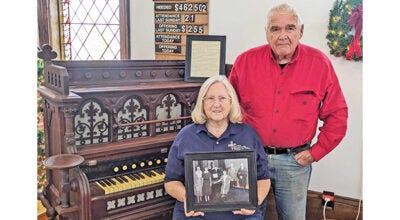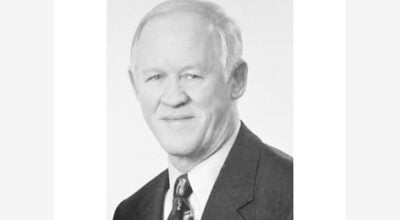Uncover the past Andrews University
Published 9:53 am Thursday, February 27, 2014

Dr. Constance Gane stands beside a replica of the Black Obelisk of Shalamannesser III. (Leader photo/JILL McCAUGHAN)
BERRIEN SPRINGS—If you’ve ever driven into Berrien Springs, chances are that you’ve driven right past the Horn Archaeological Museum at Andrews University. But, have you ever stopped and gone into the unassuming building that once served as a bank?
If you haven’t, then you have no idea the ancient treasures that lie inside, waiting to be discovered by visitors, just as they were discovered by archeologists on desert digs.
“We have quite a nice collection, actually,” said Dr. Constance Gane, curator of the museum and assistant professor of archaeology and Old Testament at Andrews. “Altogether, we have almost 9,000 artifacts.”
Named in honor of Siegfried H. Horn (1908-1993), one of the early guiding forces behind the development of Seventh-day Adventist archeology, the museum was opened up to the public in 1970. In 2003, it moved to its present location at 9047 Old U.S. 31 in Berrien Springs.
The museum actually began with the donation of a few potshards in 1938 when it was still located in Washington, D.C.
“Our jewel in the collection is our cuneiform tablets, and we have about 3,000 of them in the collection,” Gane said. “It is the seventh largest collection in the United States.”
Besides their cuneiform tablet collection—some of which even include clay envelopes. The museum features a wide range of artifacts that are housed in a number of galleries, each of which focuses on a different period of ancient history.
For example, in the museum’s lower level, visitors can browse through the Classroom Hall. There, a number of cases make up a biblical storyline that spans ancient history, beginning more than 5,000 years ago with the Early Bronze I period (ca. 3200-3000 B.C.).
In the cases, artifacts are displayed in front of murals which depict historic scenes from each period. However, unlike many such murals, the museum’s actual artifacts are featured within the paintings, thereby showing the objects in their original context.
“Nathan Greene took the Bible stories, and he used our artifacts and painted into the story some of the artifacts,” Dr. Gane explained. “It’s just brilliant!”
While each case includes many fascinating objects, some highlights in this area include an example of the type of household gods—or teraphim—that Rachel would have stolen as she and Jacob left the house of her father, Laban.
Another interesting piece in this collection is a replica of the clay Cyrus Cylinder, which tells of the fall of Babylon to the Persian king, Cyrus the Great. This artifact adds insight into the period during which Daniel would have lived.
There is also an example of a “purr,” which is the predecessor of the dice we now use for game-playing, and which is related to the Jewish holiday, Purim.
“That’s what was used to cast lots. They would roll it,” Gane explained. “Originally, it was used for divination purposes. This one is from the Mesopotamian region.”
On the main level of the museum, the Main Exhibit Hall is dominated by a life-sized, modern Bedouin tent, complete with couches upon which visitors are welcome to sit and relax.
“The great thing about these is that they are basically the same as they were during Abraham’s day,” said Gane. “He would have lived in tents like this.”
The New Testament room features a large, three-dimensional model of the city of Jerusalem which was created in 1898. Photographs of Jerusalem, taken during the same time period, provide viewers with a greater level of context by which to approach the relief.
In the Mesopotamian Hall, visitors will find ancient bricks from the cities of Babylon and Ur displayed, including one with King Nebuchadnezzar’s stamp on it. Another highlight of the room is a replica of the Black Obelisk of Shalamannesser III, which depicts conquered peoples paying tribute to that king.
“I can’t believe we have it. It’s just a wonderful treasure,” Gane said of the obelisk. “This was a huge find when it was first discovered.”
The Madaba Plains Hall highlights Andrews’ current archeological dig sites, Hisban, Jalul and Umayri. It also presents information on a cultural preservation project that Prof. Oystein LaBianca is spearheading, the creation of an Institute of Cultural Heritage at Hisban.
In the Egyptian Hall, graduate students Scott Baker and Sean Porras have cleverly transformed the old bank vault into a replica of King Tutankhamen’s tomb, complete with a replica of the sarcophagus, various mummified birds, scarabs and a life-size replica of his throne.
“This is, hands down, most people’s favorite place,” Gane said. “I just love what they did with it.”
The exhibit also features a tiny hole into which visitors can look, providing them with the same view that greeted Howard Carter when he first peered into King Tut’s tomb.
More information about the museum can be found at www.andrews.edu/archaeology. It is open on Saturdays from 3 to 5 p.m., except for holidays, but appointments to visit the museum during the week can also be made by calling (269) 471-3273. There is also a gift shop where visitors can purchase items imported from the Middle East.
As a part of Andrews University, the museum is centered on a biblical interpretation of ancient history. Nonetheless, visitors of any faith will find ancient and modern artifacts that pique their interest and stir their imagination when viewing the collections at the Horn Museum.
“This is a little hidden treasure,” Gane said. “It really is.”





